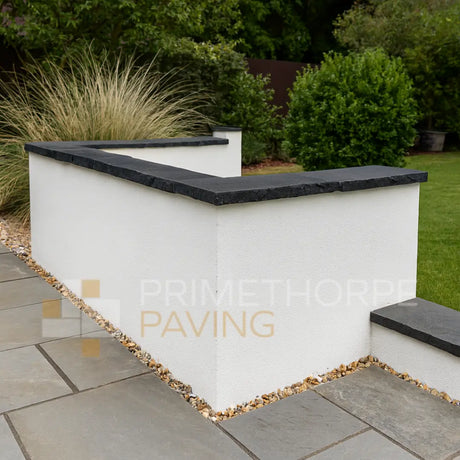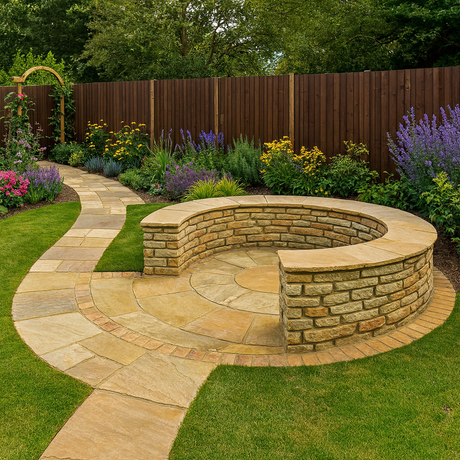If you ask any landscaper worth their salt, “what’s the most important part of a patio” all of them - without exception - will state it’s the foundation. The layer you can’t even see! I
nvesting extra into the foundations of your patio is a very wise investment. Investing more in appropriate premium products, will extent the lifetime of your patio more than any other investment will. This isn’t sticking up some wallpaper whenever you get a change of heart! This is a job you want done once, and once only. So it is worth the proper investment.
And that's the other thing - it's wise to spend slightly more and invest in more durable, strong materials to mitigate the risk of needing to relay your paving in the future.
If you lay your sub-base for patio correctly and pick durable patio materials, it can last for 50 years or more.
Read on for an expert guide to sub base for patio paving and how to get it right.
What is a Sub Base for a Patio?
A sub-base is a layer of compacted aggregate material you should put underneath the material you select for your paving. As the name suggests, it forms the base of your patio.
To form a solid base, you should evenly distribute the weight across the m2 to prevent sinking and keep the surface solid for the 50 years or more we mentioned.
A sub-base should also absorb and distribute pressure on the patio from foot traffic, furniture, the normal displacement beneath it, or anything that could put pressure on your patio.
Sub-bases are particularly essential for outdoor areas because they greatly reduce chances of water damage, for example - from the frequent freeze-thaw cycles during winter in the UK - as they increase drainage, making the base more stable.
The Best Sub-Base Materials
Selecting the correct sub-base material is essential. Here are some of the best options
Type 1 MOT
Type 1 MOT is the most commonly used base material across the UK for homeowners.
Type 1 MOT is made of crushed limestone or granite, with composition variations from fine dust to 40 millimetres. It's easily compacted, making it very ideal for use as a sub-base in patios. And type 1 MOT meets British Standards (BS), confirming its use as a load-bearing material. It is standard practice to lay down a minimum of 100mm of compacted Type 1 MOT on patios.
Sand and Gravel Mixes
Mixes of sand and gravel are typically more unstable than the MOT aggregates, but that doesn't mean they don't work.
You can use it for smaller patios or areas you know won't necessarily experience much external pressure. Sand and gravel are the cheaper options per kg. This is fine for a small-ish DIY project and is better than nothing! But if you are paying for, or are looking to create a professional-level job, this should not be considered at all.
How to Calculate Your Patio Sub-Base Requirements
If you're wondering how much sub base do I need for patio paving, there's a way of calculating it to get the quantities correct. Here's a step-by-step guide to calculating the materials:
- Measure the Area: Calculate the length and width of the patios in meters. Then multiply these figures to obtain the full area coverage in square meters (m²). For example, a 5m by 3m patio would result in an area of 15 m².
- Determine the Depth of the Sub-Base: It depends on what you'll use the patio for, but a depth of 100mm (0.1 m) is the standard depth.
- Calculate the Volume: You can calculate the volume of the sub-base by multiplying the depth (100mm) and the area (in m²). Using the example we gave above; 15 m² (area) by 0.1 m (depth) = 1.5 m³.
- Apply the Compression Factor: The compression factor for Type 1 MOT means you can multiply the volume by 1.3.
- Convert to Tonnes: For compacted Type 1 MOT, you can multiply the volume by 1.1 and then by 1.6 to get the total tonnage. If you wish to use the metric system, use a metric tonne.
Laying the Sub-Base for Your Patio
With your measurements and the best sub-base material, you can take the steps to lay sub base for patio so it lasts. Here's a straightforward guide:
- Clear and Prepare the Site
- Add the Sub-Base Material: Spread the sub-base material evenly across the designated area and to the required patio sub-base depth. Use a rake to level it out.
- Compact the Material: Compaction is essential for a stable sub-base. You can hire a plate compactor to compress the material sufficiently. Ensure you pass over it multiple times for a solid and level surface.
- Check the Levels: Check the levels with a spirit level. A sub-base should have a slight slope (1:80). That'll allow for water runoff and prevent pooling.
- Add a Layer of Bedding Sand (Optional): Some people like to add a thin layer (around 25mm) of sand on top of the compacted sub-base. That thin layer of sand will create a smooth, even surface for laying pavers.
The Benefits of Using a Sub-Base
There are numerous benefits to laying a sub-base for your patio.
- Enhanced stability
- Better drainage
- Longer lifespan
- Cost savings on repairs
- Protection against weathering
A durable, correctly laid sub base for patio will make a massive difference to the overall finish and the lifespan of your patio. And it's not necessarily tricky. As long as you know the measurements, create an even sub-base, and use durable materials, you can easily DIY it at home.
Primethorpe Paving is here to help you make the most of your investment.






